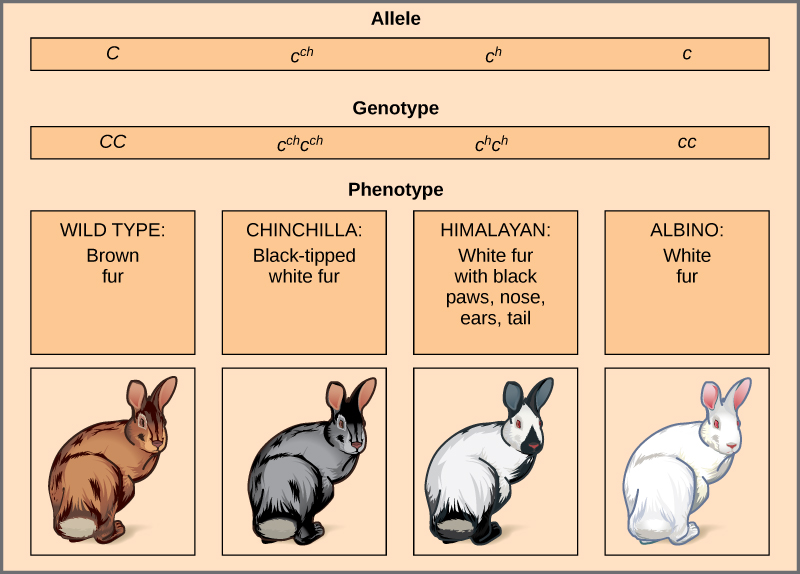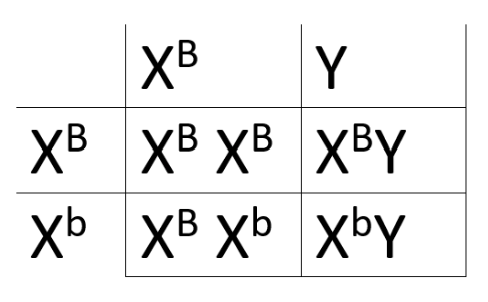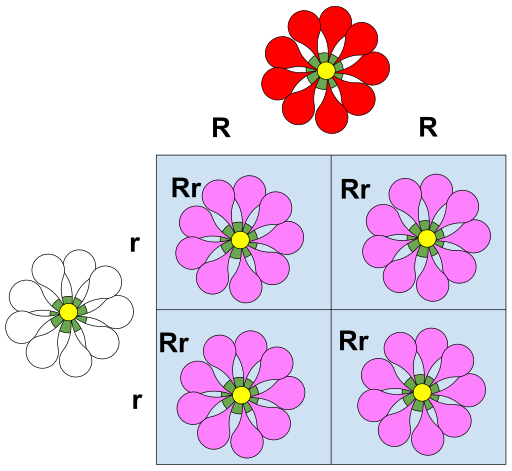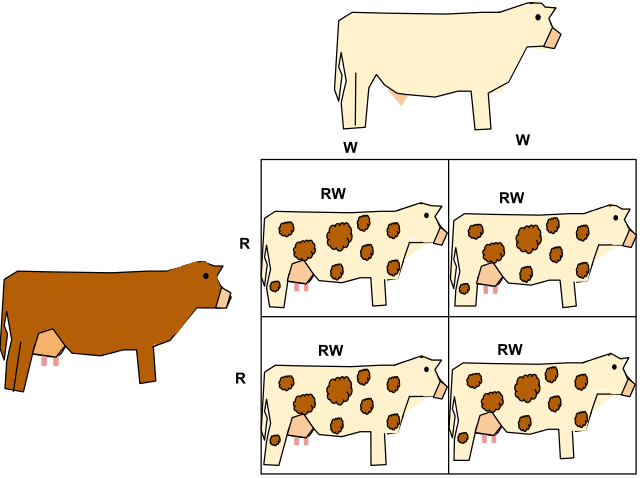H
Haseung Jun
C
Caroline Koffke
H
Haseung Jun
C
Caroline Koffke
AP Biology 🧬
358 resourcesSee Units
Most traits actually do not follow Mendel’s laws of dominant and recessive inheritance. The inheritance of these traits is referred to as Non-Mendelian genetics. A few important Non-Mendelian inheritance patterns are multiple alleles, sex-linked traits, incomplete dominance, and codominance.
Multiple Alleles
A lot of human traits are said to have multiple alleles. As opposed to just having a dominant and recessive version of an allele, there may be more than two versions of a gene that contribute to the overall phenotype.
In humans, blood type is a strong example of a trait that has multiple alleles. Another common example of multiple alleles is fur color inheritance in a certain species of rabbits. This is highlighted below.

Image courtesy of WikiMedia Commons.
As shown in this image, there is a dominant C allele and three different recessive c alleles. The combination of inheritance of these various alleles results in four different phenotypes.
Sex-Linked Traits
Sex-linked traits are traits that exist on a sex chromosome, X or Y. Most frequently, these traits lie on the X chromosome. Because of this, males are more likely to inherit these disorders because they only have one X chromosome, and, therefore, cannot be heterozygous.
Common examples of sex-linked traits are colorblindness and hemophilia. Both of these disorders are carried on the X chromosome. An example of how a Punnett square for a sex linked trait would be set up is shown below.

This Punnett square shows a mom (XBXb) who is heterozygous for color blindness. Because color blindness is recessive, she has normal color vision, but is a carrier of the recessive allele.
There are also two boys. One has the dominant allele, XBY, and will have normal color vision. The other has the recessive allele, XbY, and will be colorblind.
The dad (XBY) has the dominant allele for this trait and, therefore, has normal color vision as well. Yet, when these two parents are crossed, there is a possibility that some of their offspring will be colorblind.
In this Punnett square there are two girls on the left-hand side. One is homozygous dominant (XBXB) and one is heterozygous (XBXb). Both will have normal color vision.
Incomplete Dominance
Incomplete dominance refers to traits where neither allele is dominant over the other. A good example of this is with flower colors. There are some species of flowers that have both red and white coloration, but neither is dominant. Heterozygous individuals have a combination of both colors, creating pink flowers.

Image courtesy of WikiMedia Commons.
Even though there are capital and lowercase letters shown above, neither of these alleles is dominant, hence why there isn’t one color over the other in the heterozygous offspring.
Co-dominance
Co-dominance refers to traits in which both alleles are equally dominant (think: co-captains). A good example of this is spots on certain breeds of cow. Some cows of this species are red, some are white, and some have red and white spots. Both alleles show up equally in the heterozygous offspring.

Image courtesy of WikiMedia Commons.
As you can see, all of the heterozygous offspring have a mix of both parental phenotypes, showing that neither is more dominant than the other.
Non-Nuclear Inheritance
Some traits result from non-nuclear inheritances, which are inheritances from organelles.
- chloroplasts and mitochondria are randomly assorted, so the traits determined by chloroplast and mitochondrion do not follow Mendelian rules
- mitochondria are inherited from the maternal side (your mitochondrion actually comes from your mother, maternal grandmother, etc.) so this doesn't follow Mendelian rules either
- chloroplasts are inherited from the maternal side (ovule) in plants just like animals, so chloroplast-determined traits are maternally inherited.
Check out the AP Bio Unit 5 Replays or watch the 2021 Unit 5 Cram
Browse Study Guides By Unit
🧪Unit 1 – Chemistry of Life
🧬Unit 2 – Cell Structure & Function
🔋Unit 3 – Cellular Energetics
🦠Unit 4 – Cell Communication & Cell Cycle
👪Unit 5 – Heredity
👻Unit 6 – Gene Expression & Regulation
🦍Unit 7 – Natural Selection
🌲Unit 8 – Ecology
📚Study Tools
🧐Exam Skills

© 2025 Fiveable Inc. All rights reserved.